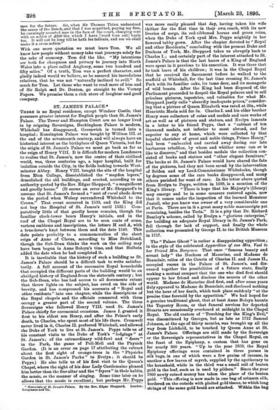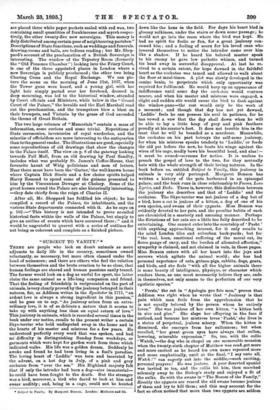ST. JAMES'S PALACE.*
THERE is no Royal residence, except Windsor Castle, that possesses greater interest for English people than St. James's Palace. The Tower and Hampton Court are no longer lived in by reigning Sovereigns, Buckingham Palace is modern, Whitehall has disappeared, Greenwich is turned into a hospital ; Kensington Palace was bought by William III. at the end of the seventeenth century, and will always have an historical interest as the birthplace of Queen Victoria, but for the origin of St. James's Palace we must go back as far as the reign of Henry VIII. It is difficult for modern Londoners to realise that St. James's, now the centre of their civilised world, was, three centuries ago, a leper hospital, built for isolation outside the City, in the fields looking towards West- minster Abbey. Henry VIII. bought the site of the hospital from Eton College, disestablished the " mayden lepers," demolished the old buildings, and erected, according to an authority quoted by the Rev. Edgar Sheppard, "a magnificent and goodly house." (It seems an error of Mr. Sheppard's to assume that St. James's formed a "sort of rural abode down to the period when WoL3ey surrendered Whitehall to the Crown." That event occurred in 1530, and the King did not buy the Hospital of St. James's until 1532.) Coin- paratively little of that goodly house remains, though the familiar clock-tower bears Henry's initials, and in the roof of the Chapel Royal are to be seen coats of arms, various emblems and inscriptions, the letters H and A, with a true-lover's knot between them and the date 1540. This date points probably to a commemoration of the short reign of Anne of Cleves, according to Miss Strickland, though the Sub-Dean thinks the work on the ceiling may have been began in Anne Boleyn's time, and that Holbein added the date when he had completed it.
It is inevitable that the history of such a building as St. James's Palace should be a difficult task to write satisfac- torily. A full account of the successive Royal households that occupied the different parts of the building would be an abridged history of England from the sixteenth century ; but the Sub-Dean, who has had access to all documents extant that throw lights on the subject, has erred on the side of brevity, and has compressed his accounts of "Royal and other residents" into one chapter, while the descriptions of the Royal chapels and the officials connected with them occupy a greater part of the second volume. The three Sovereigns who followed Henry VIII. used St. James's Palace chiefly for ceremonial occasions. James L granted it first to his eldest son Henry, and after the Prince's early death, to Charles, who spent most of his life there. Cromwell never lived in it, Charles II. preferred Whitehall, and allowed the Duke of York to live at St. James's. Pepys tells us of his constant visits to the Duke of York's " lodgings " at St. James's ; of the extraordinary wild-fowl and " deere"
in the Park, the game of Pell-Mell and the Physick Garden. (It is an error on page 17 attributing the extract about the first sight of orange-trees in the " Physicke Garden in St. James's Parke" to Evelyn ; it should be Pepys.) He also tells us of his first visit to the Queen's Chapel, where the sight of his dear Lady Oastlemaine pleased him better than the fine altar and the "fryers" in their habits, the music, or the manner of singing. Some time later on he allows that the music is excellent ; but perhaps Mr. Pepys
• Mortorialo of St. Jaines's Palace. By the Rey. Edgar Sheppard. London: Longmans and CO.
was more easily pleased that day, having taken his wife thither for the fist time in their own coach, with its new liveries of serge, its red-ribboned horses and green reins, when the Duke of York eyed Mrs. Pepys mightily in her flowered tabby gown. After the chapter devoted to "Royal and other Residents," concluding with the present Duke and Duchess of York, Mr. Sheppard takes us abruptly back to Charles I.; and certainly part of the interest attached to St. James's Palace is that the last hours of a King of England were spent in it previous to his execution. It was there that he took leave of his children ; it was in the Chapel Royal that he received the Sacrament before he walked to the scaffold at Whitehall, for the last time crossing St. James's Park with its familiar oaks, its tame deer, and its menagerie of wild beasts. After the King had been disposed of, the Parliament proceeded to despoil the Royal palaces and to sell priceless pictures, tapestries, and valuables for what Mr. Sheppard justly calls "absurdly inadequate prices," consider- ing that a picture of Queen Elizabeth was rated at 20s., while Henrietta Maria sold for 5s. Charles I. and his elder brother Henry were collectors of coins and medals and rare works of art as well as of pictures and statues, and Evelyn laments in a letter to his friend Pepys, that a "cabinet of ten thousand medals, not inferior to most abroad, and far superior to any at home, which were collected by that hopeful cherisher of great and noble things, Prince Henry," had been "embezzled and carried away during our late barbarous rebellion, by whom and whither none can or is like to discover," and that besides medals the collection con- sisted of books and statues and "other elegant furniture." The books at St. James's Palace would have shared the fate of the pictures, had they not been saved by the intervention of Selden and my Lord-Commissioner Whitelocke, though by degrees some of the rare books disappeared, and many others perished for want of care. In. the letter above quoted from Evelyn to Pepys, written in 1689, is a mention of the King's library. "There is hope that his Majesty's (library) may emerge and be in some measure restored again, now that it comes under the inspection of the learned Monsieur Justell, who you know was owner of a very considerable one at Paris. There are in it a great many noble manuscripts yet remaining, besides the Tecla." It is a pity that Dr. Richard Bentley's scheme, called by Evelyn a "glorious enterprise," for building an adequate Royal library in St. James's Park, fell through for lack of support, and finally the whole collection was presented by George IL to the British Museum in 1757.
The "Palace Ghost" is rather a disappointing apparition ; in the style of the celebrated Apparition of one Mrs. Veal to her Friend Mrs. Bargrave. That once " famous beauty and errant lady" the Duchess of Mazarine, and Madame de Beauclair, relics of the Courts of Charles IL and James II., occupied rooms in the Palace of St. James's, and dis- cussed together the possibilities of a future state, finally making a mutual compact that the one who died first should appear to her friend and disclose the secrets of the other world. Madame de Mazarine died first, and after some years duly appeared to Madame de Beauclair, and disclosed nothing but the hour of her death, which took place suddenly "at the precise time foretold by the apparition." We had hoped for a genuine traditional ghost, that at least Anne Boleyn haunts the Tapestry Room, or that funeral services for departed Stuarts are occasionally overheard at midnight in the Chapel Royal. The old custom of "Touching for the King's Evil," was discontinued by Georges, but as late as 1712 Samuel Johnson, at the age of thirty months, was brought up all the way from Lichfield, to be touched by Queen Anne at St. James's Palace. Offerings are still made by the Sovereign or the Sovereign's representatives in the Chapel Royal, on the feast of the Epiphany, a custom that has gone on for nearly 800 years. "Up to the year 1859, the Royal Epiphany offerings were contained in three purses in silk bags, in one of which were a few grains of incense, in another a few leaves of myrrh, supplied by the apothecary to the household, while in the third was a small roll of beaten gold in the leaf, such as is used by gliders." Since the year 1860 newly coined money has taken the place of the beaten gold. "This offering is now made in one bag of crimson silk, bordered on the outside with plaited gold tissue, to which long strings of the same gold braid are attached. Within the bag
are placed three white paper packets sealed with red wax, two containing small quantities of frankincense and myrrh respec- tively, the other twenty-five new sovereigns. This money is duly distributed among certain poor of neighbouring parishes." Descriptions of State functions, such as weddings and funerals, drawing-rooms and balls, are tedious reading ; but Mr. Shep- pard's account of the proclamation of a British Sovereign is interesting. The window of the Tapestry Room (formerly the "Old Presence Chamber ") looking into the Friary Court, is one of the three appointed places in London where a new Sovereign is publicly proclaimed ; the other two being Charing Cross and the Royal Exchange. We can pic- ture the scene on the morning of June 21st, 1837, when the Tower guns were heard, and a young girl, with her light hair simply parted over her forehead, dressed in deep mourning, was led to the historical window, attended by Court officials and Ministers, while below in the "Grand Court of the Palace," the heralds and the Earl Marshall read out the proclamation, and the trumpeters blew a blast on their trumpets, and Victoria by the grace of God ascended the throne of Great Britain.
The two large volumes of "Memorials" contain a mass of information, some curious and some trivial. Repetitions of State ceremonies, inventories of royal wardrobes, and the minutim of officialdom are more interesting to the antiquarian than to the general reader. The illustrations are good, especially some reproductions of old drawings that show the changes in the Palace itself. The view on p. 8 of the gateway looking towards Pall Mall, from an old drawing by Paul Sandby, includes what was probably St. James's Coffee-House, that favourite haunt of Whig politicians and men of letters. Near there must have been the Garter,' the well-known house where Captain Dick Steele and a few choice spirits helped Harry Esmond to spend some of the guineas presented to him by the Viscountess Dowager at Chelsey. Some of the great houses round the Palace are also historically interesting, —they date chiefly from the reign of Charles II.
After all, Mr. Sheppard has fulfilled his object; he has compiled a record of the Palace, its inhabitants, and the various State departments connected with it. As he says on p. 102:—" This history is not intended to prove so-called historical facts within the walls of the Palace, but simply to give an outline of events which have occurred there ; " and it would be ungrateful to quarrel with a series of outlines for not being as coherent and complete as a finished picture.







































 Previous page
Previous page